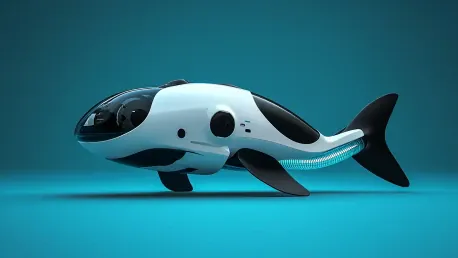The development of an innovative, miniature swimming robot inspired by marine flatworms has set a new benchmark in the field of bioinspired robotics. This breakthrough robot was developed by researchers from the Soft Transducers Lab and the Unsteady Flow Diagnostics Laboratory at EPFL’s School of Engineering, in collaboration with the Max Planck Institute for Intelligent Systems. The robot has compelling potential applications, particularly in environmental monitoring, pollution mapping, and precision agriculture. Its design and technological advancements highlight a significant milestone in developing robotic systems that mimic the efficiency and agility of natural organisms.
Innovative Design and Functionality
Unique Propulsive Mechanism
The standout feature of this newly developed robot lies in its unique propulsive mechanism, which diverges significantly from traditional underwater robots that typically use propellers for movement. Inspired by marine flatworms, this robot utilizes undulating fins to navigate through the water fluidly. By adopting this design, the robot can move silently, thereby minimizing its disturbance to aquatic ecosystems and preserving the natural behaviors of surrounding wildlife. This silent operation proves particularly valuable for ecological studies where minimizing human impact is crucial.
Agility and Speed
In addition to its silent movement, the robot showcases exceptional agility and speed, safeguarded by four artificial muscles that propel its undulating fins. These muscles enable the robot to swim forward, backward, and even sideways with remarkable dexterity. The robot can oscillate its fins up to ten times faster than natural flatworms, reaching speeds of up to 12 centimeters per second, which corresponds to an impressive 2.6 body lengths per second. This level of agility and swiftness makes the robot exceptionally suited for confined spaces and cluttered water surfaces and elevates its potential in tasks that demand precision and rapid movement.
Technological Advancements
Soft Actuators and Locomotion Strategies
The journey to develop an untethered, ultra-thin robot for underwater environments presented the research team with unique, formidable challenges, which they overcame through remarkable technological innovations. Central to their success was the development of advanced soft actuators and innovative undulating locomotion strategies. These breakthroughs allowed the robot to mimic the agile, fluid movements of marine flatworms. The powerful soft actuators enable the robot to execute complex maneuvers with grace and efficiency, closely mirroring the agile swimming behaviors observed in natural flatworms.
Miniature Electronics and Autonomy
A critical milestone in the robot’s development was the integration of a compact electronic control system capable of delivering up to 500 volts to the robot’s actuators. Remarkably, this system operates with an energy efficiency of only 500 milliwatts, which is four times less than the power consumption of an average electric toothbrush. This energy efficiency is complemented by incorporating light sensors that enable the robot to autonomously navigate toward light sources, emulating simple visual systems found in nature. By enhancing the robot’s autonomy, researchers have paved the way for future iterations to perform more complex and independent tasks in underwater environments.
Overarching Trends and Consensus
Blending with Natural Environments
A recurring theme in the field of bioinspired robotics is the pursuit of designs that blend seamlessly with natural environments. The new flatworm-inspired robot exemplifies this trend through its ability to move silently and fluidly underwater, much like a natural organism. This capability opens new possibilities for ecological studies and environmental monitoring by reducing human intrusiveness and allowing researchers to observe aquatic habitats in their undisturbed state. The robot’s quiet operation ensures minimal disruption to the ecosystem, making it an excellent tool for sensitive environmental tasks.
Minimal Ecological Footprints
The trend toward developing robotic systems with minimal ecological footprints is evident in this bioinspired robot’s design and functionality. As scientists strive to create more efficient and eco-friendly technologies, the flatworm-inspired robot stands as a shining example of balancing advanced robotics with ecological sensitivity. Its unobtrusive movement and energy-efficient operation underscore the importance of designing robots that accomplish their tasks efficiently while preserving the natural environment. This intersection of robotics advancement and ecological consideration marks the robot’s significance as a pioneer in environmentally conscious technology.
Main Findings and Implications
Environmental Monitoring
The precision and agility of the flatworm-inspired swimming robot make it invaluable for environmental monitoring and pollution tracking in delicate aquatic ecosystems. Its ability to navigate tight, cluttered spaces, combined with its silent operation, allows it to gather data with minimal disturbance to the habitat. This capability is particularly beneficial for studying sensitive environments where traditional methods might be too invasive or disruptive. Researchers can use this robot to conduct thorough ecological assessments, water quality monitoring, and identify sources of pollution without significantly impacting the areas under investigation.
Future Research and Applications
Researchers at the Soft Transducers Lab and the Unsteady Flow Diagnostics Laboratory at EPFL’s School of Engineering, in cooperation with the Max Planck Institute for Intelligent Systems, have created a groundbreaking miniature swimming robot inspired by marine flatworms. This innovative bioinspired robot marks a new milestone in the world of robotics, mimicking the efficiency and agility of natural organisms. The design and technological advancements of this tiny robot have opened up exciting potential applications. Among these are environmental monitoring, where the robot could be used to observe and collect data in various water bodies. It also holds promise for pollution mapping, detecting and tracking pollutants in real time, thereby aiding in environmental conservation efforts. Furthermore, the robot could be utilized in precision agriculture, where it might assist in monitoring plant health and soil conditions more accurately. This remarkable creation underscores the potential for bioinspired robotics to transform multiple areas by leveraging the efficiency of natural organisms.









